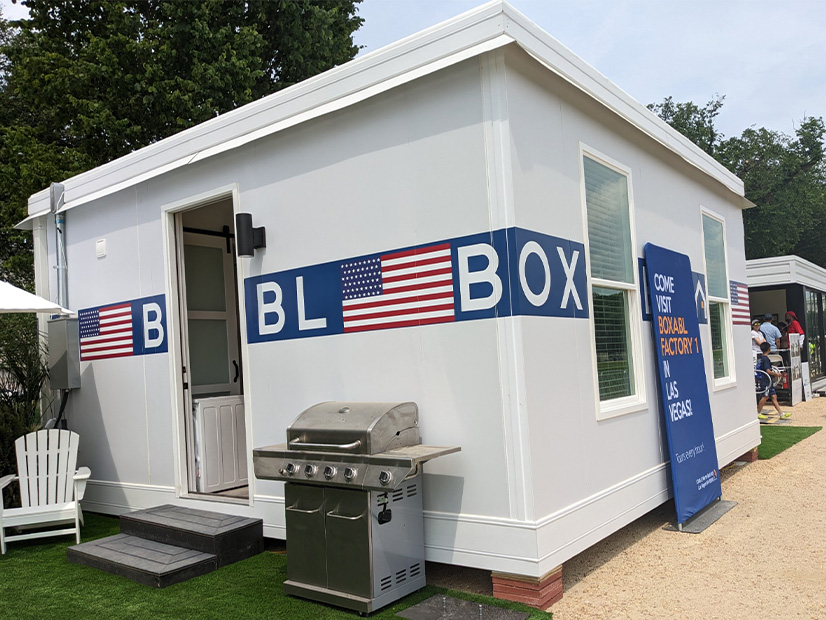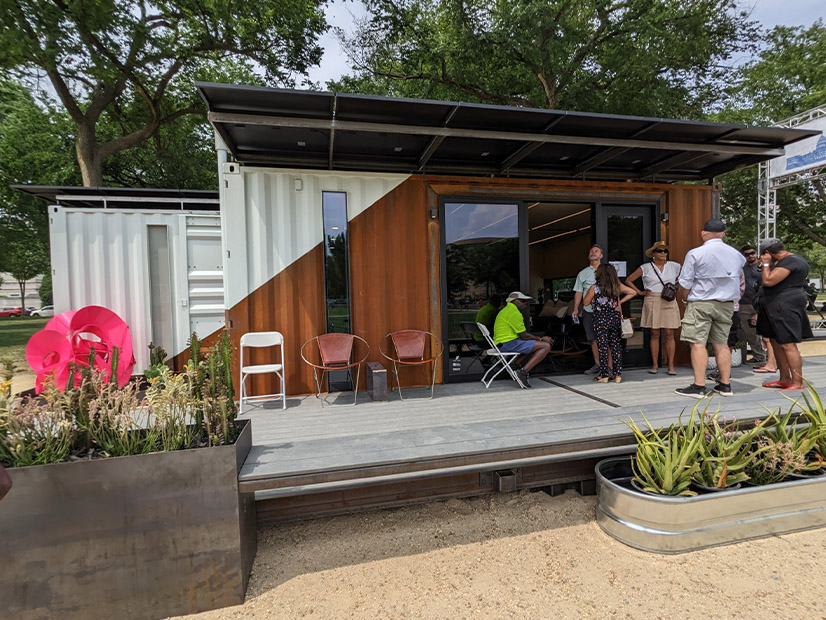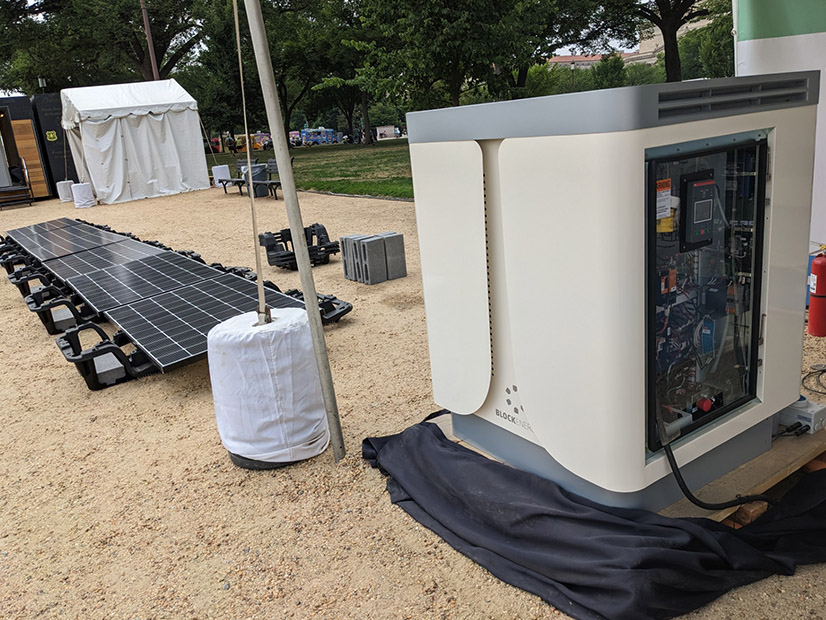
WASHINGTON ― Patti Gunderson, a building science engineer at the Pacific Northwest National Laboratory, is passionate about windows, so when Housing and Urban Development (HUD) Secretary Marcia Fudge stopped by the PNNL exhibit at the Innovative Housing Showcase on the National Mall on Friday, she got an earful.
Double-pane windows may be the standard, but PNNL is now pushing triple-pane windows that provide even more energy efficiency and savings, Gunderson told Fudge. But the first triple-panes were heavy and wider than standard window frames, and “it’s been very difficult to get industry to accept them,” she said.
PNNL has been working with a consortium of researchers and builders, “so what happened with triple-pane technology is they are now narrow enough … that they could fit into a standard frame that has always been used for doubles,” Gunderson said, “So all of a sudden, regular manufacturers can build them, make them available to the public, and the public can have a much better window.”
Triple- and even double-panes are expensive, so for a cheaper alternative, Gunderson showed Fudge a thermal window insert — an acrylic pane with a flexible frame — that creates “an excellent seal,” she said. “We’ll put in a pane like this over an existing window that actually operates and … all of a sudden you’ve got almost double-pane performance.”
Fudge spent Friday morning at the HUD-sponsored showcase, talking with exhibitors like Gunderson and visiting model houses that are super energy efficient and, in some cases, already on the market and expanding options for affordable, high-quality housing that can be brought in quickly in emergencies.

Las Vegas-based Boxabl has developed a 361-square-foot “casita” that folds up into an 8½-by-19-foot cube so “we can put it on a trailer and ship it without [needing] a wide load,” said Jennifer Katz, vice president of strategic investments. “And it comes with all the appliances for you,” including a combo washer-dryer.
Katz sees a wide market for houses like the casita in workforce and military housing. The house can be unfolded and assembled in a couple of hours, although a local contractor has to complete the electric and water hookups onsite, she said. Inside, the cube has a full kitchen with significant cabinet space, a decent-sized bathroom — with yet more cabinets — and a bed alcove and living room. In other words, it’s small, but it doesn’t feel constricted, and Katz said the company can stack or connect the units for a larger residence.
The homes can be folded up, moved and reassembled up to 10 times without affecting structural integrity, Katz said. So far, the company has built and sold 400 of the homes — including one for Tesla CEO Elon Musk — and it is rapidly expanding its manufacturing capacity.
 Inside the cube, a full kitchen. | © RTO Insider LLC
Inside the cube, a full kitchen. | © RTO Insider LLCFudge was impressed. “For us to do something like this … says that we can start to solve our housing problems if we but want to do it,” she said. “We have to build more density.”
On the Mall
The message from Boxabl and other companies exhibiting model homes on the Mall during the three-day showcase is that well-designed green housing is breaking out of its customized, high-priced niche but still has a way to go to become the standard rather than the exception.
In Phoenix, Ariz., Steel + Spark has developed off-grid housing, the Sparkbox, using shipping containers insulated 20% above international building codes and powered by solar panels and battery energy storage. Working with the city, the company will soon be constructing a project it is calling X-wing, which will demonstrate the use of shipping containers for off-grid emergency housing.
Each X-wing unit will consist of four containers connected by two custom core modules, said Steel + Spark founder Brian Stark. Four of the units will be installed on a city-owned lot.
 Steel + Spark turns shipping containers into off-grid housing with solar and storage. | © RTO Insider LLC
Steel + Spark turns shipping containers into off-grid housing with solar and storage. | © RTO Insider LLCIn Pittsburgh, Pa., Module is targeting the urban infill market — putting new homes on small urban lots — built to the U.S. Department of Energy’s Zero Energy Ready Home (ZERH) standard. ZERH homes are so energy efficient that adding rooftop solar could offset the household’s energy use, and they may be eligible for a $5,000 tax credit under the Inflation Reduction Act.
In dollars and cents, savings on electric bills come out to about 80% under a standard home, said Drew Brisley, Module’s chief product officer.
One of Module’s first projects was a three-house infill site in Pittsburgh, and the company is now preparing for a 10-unit project, Brisley said. The company’s designs are modular, so “what is coming from our factory is a full volumetric box,” which can be stacked one on top of the other “like Lego blocks,” he said.
 Module’s Black Street project of three infill houses in Pittsburgh | Module Design
Module’s Black Street project of three infill houses in Pittsburgh | Module Design
The cost per home out of the factory is $200,000, appliances included, Brisley said. The company is fielding inquiries from across the country, he said, “but we feel like the opportunity that makes the most sense is the Mid-Atlantic,” in cities like Pittsburgh, Washington, D.C., and Baltimore.
Florida-based BlockEnergy has still another approach to energy-efficient, resilient housing: utility-owned, front of the meter, direct current solar and storage community microgrids. Each home in a community has solar and storage and “can operate on its own … but it’s more powerful if it can participate with its neighbors,” said Gary Oppedahl, the company’s vice president of emerging technologies, “All the storage in this system is shared, as is the solar generation, because it’s all on the front side of the meter.”
 BlockEnergy is developing community microgrids with front-of-the-meter solar and storage projects. | © RTO Insider LLC
BlockEnergy is developing community microgrids with front-of-the-meter solar and storage projects. | © RTO Insider LLC
A “BlockBox” combines storage, an inverter and system management, so if a homeowner wants energy, “the inverter switches into split-phase AC and [electricity] goes in through the meter to the home,” Oppedahl said at a pre-showcase conference at the National Building Museum on Thursday.
Such microgrids could provide future proofing for homes as they electrify, he said. EV chargers and some HVAC systems run on DC, so the system could provide power to them directly rather than first converting to AC and then back to DC, with the associated power loss. The homeowner pays nothing up front, and the utility buys and manages the system “instead of buying capacity at a local coal-fired or gas-fired plant,” Oppedahl said.
With a group of microgrids, the systems could provide ancillary services and even black start capability for the distribution grid, he said. Partnering with a local utility, BlockEnergy has piloted the system for over a year in a community of 37 homes in Florida, where residents were able to ride out Hurricane Ian in 2022 without even having “to reset their microwave clocks,” Oppedahl said. “Each home is like a cell phone: It’s running off the battery all the time.”
A second project in Prince George’s County, Md., will break ground this summer, he said.
The Retrofit Market
While the houses on the Mall provided a glimpse of the cool, energy-efficient housing now on the horizon, a major challenge for Fudge, Gunderson and other participants at the event is how to bring the same level of energy efficiency to the nation’s existing, often inefficient housing stock.
Close to half of all homes in the U.S. were built before 1980, and more than a third were built before 1970, according to the National Association of Home Builders. In addition, many states have yet to adopt the latest, most energy-efficient building codes.
The impact on home comfort and energy bills can be significant. For example, Gunderson noted that while windows constitute only about 7% of a home’s exterior, older windows may account for as much as 48% of the building’s heat loss.
Eric Werling, director of the ZERH program, said the home building sector is poised for transformation but the process of change is uneven due to tricky market dynamics.
“The theory of change was that if we can help early adopters to be profitable on selling a better product — and by better, what we meant was adding efficiency and comfort and health protections — then the rest of the market would copy that,” he said. “The bad news is … that the top performers are never emulated by the bottom performers in the market.”
Policies and incentives are needed to encourage the adoption of higher standards, he said, along with industry-supported building codes to ensure bottom performers don’t undercut the rest of the field. Many cities are adopting building performance standards for their commercial buildings, but not for residential, he said.
Sven Mumme, DOE’s acting manager for emerging technologies, said that beyond price, the technologies for home retrofits must be made more accessible and easier to use. While the White House and DOE are heavily promoting heat pumps, Mumme said, many models require an electrical panel upgrade to 240 volts, as opposed to a home’s standard 120-volt plugs. Having 120-volt heat pumps will reduce upfront costs and speed deployment, he said.
Mumme and Werling also spoke about the challenges of training contractors to combine energy efficiency with other home improvements.
“There are 1 to 2 million re-siding projects that are done each year in the residential sector,” Mumme said. “So, 99% of the time they just add … [new] siding back on,” missing a key opportunity to improve a home’s insulation.
“If we had a low-cost, high-performing, insulated siding product … that would be a game changer if we can utilize the greater workforce to basically convert siding projects to efficiency,” he said.



